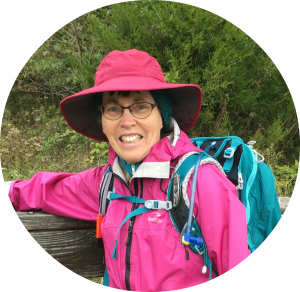There is probably no post that has been on my “must write this” list for longer than the one you are now reading. Even more: weeks before it made it to my actual list back in October, it was meandering around my mind. Had it actually been written back in the fall, it would likely have been called “Seeking Solitude” or “Going WIthin” or “The Challenge of Silence.” But my wandering thought, as it journeyed through my psyche for months, picked up extra baggage along the way. Isn’t that typical of any traveler?
And so, to the challenge of embracing solitude and being productively silent as I carried out my training walks, I recently added the challenge of coming up with more “s” words to keep those two company. The catch? The words had to be at least tangentially related to my trek across Spain. (I’m practiced in this sort of thing. To entertain myself on multi-day bike tours I’ve dedicated “empty time” to the task of coming up with words beginning with different letters of the alphabet. [Try it with “f”; I promise you that “f” words are to die for. Have a go with “t” and “p,” especially if most of your energy is engaged in hill climbing; for the easier flatlands, you might play with “q” or “z.” Only if you have masochist tendencies….]
You are totally within your right mind if you are starting to think that I have lost mine. Perhaps you are wondering why you should bother to read this strange post. You probably shouldn’t! You have better things to do. For that matter, I probably shouldn’t write it. No, I definitely shouldn’t! There, I’ve said it! It is likely to be silly and superfluous, kind of like my “7 x 7”–“Seven x Seven”–post (find it here). But when have “shouldn’ts” ever stopped me? And who knows what scraps and snippets of sabiduría [wisdom] I might come up with?
Seeking solitude
Oh, yes! Silence! Solitude! Time to pray! Find myself! Dialogue with the One who first loved me! Be one with everything and everybody! It will be wonderful! Such were my early thoughts as my mind placed myself on the Camino. All that free time where the only thing my body would have to do would be put one foot in front of the other, my mind being free to wander where it would. No distractions or interruptions. No responsibilities. No to-do lists. Ah, heaven!
I remember exactly where I was when I came up with the “theme” of my Camino: “Walking the Camino / Touching the Worldl” (If you haven’t read my “Come with me!” page where I explain this theme, please click here and check it out.) It was late May, I believe. Ken and I were biking on a rail trail near Fillmore, Indiana, but in my mind’s eye I was envisioning myself on the Camino. It was another month before I began to declare to the world that I was Camino-bound, but the theme came to me during that bike ride. I was flying high as I imagined all the lofty, selfless, “other-centered” thoughts I would have.
Imagine my surprise, then, when I realized just how uncomfortable I sometimes am with silence and solitude while walking and how hard I sometimes find it to have deep conversations with either God or myself. I wasn’t prepared for this. Why was it different from biking? Quite often I ride alone, or at least not side-by-side with another rider, and I find that my thoughts generally keep me fairly well entertained.. But then I guess I am not usually anticipating “spiritual enlightenment” from those thoughts. The Camino-training walks, on the other hand, were meant to be different, weren’t they? I was expecting to do some soul-searching and, rather foolishly, I thought that would be easy, that all it would take would be the sum of two parts: me + those “lovely, dark, and deep” woods. The magic formula!
Oh, foolish me! It wasn’t–hasn’t been–easy at all!
The trees, the flowers, the plants grow in silence. The stars, the sun, the moon move in silence. Silence gives us a new perspective.
–SAINT MOTHER TERESA
That quote arrived in my email as my “Word of the Day” from The Network for Grateful Living on October 21. I immediately knew it was meant to be incorporated into this post which I was trying to birth. Yes! Growth and silence go hand in hand. The saints have all known that. I jotted it down for future reference. Now get this: that same day, what does cousin (and–though unbeknown-to-us-at-the-time–fellow pilgrim) Ginny send me? That same quote, from the same source, with this accompanying note: “Good thoughts for solo hiking :)” How did she know that I was “fighting” silence? That I needed some prodding and encouragement? I sent Ginny this response: It is SO SO funny that you forwarded this to me today. I subscribe to this site as well (I think you got to it from something I forwarded to you) and so I saw this first thing this morning. At 6:45 am I resent it to myself with a subject line: something to incorporate into a blog post–quote about “silence”. And then I added a “to do” on my “to do” list about it as well. YES! A lesson I need to learn!
Because that’s the thing. I confess to the tendency to avoid silence, to pay it lip service while running in the opposite direction or at least putting it off until “later.” Need an enumeration of my sins? Picture me walking for only a few minutes before I succumb to temptation. I insert my ear buds and then:
- I leave voice mail messages until I reach someone free to engage in a long catch-up conversation
- I listen to an audiobook for “just one more chapter” (and you know what a slippery slope that is!)
- I choose an iTunes playlist and groove out to music I love
Then, of course, there is the granddaddy of all, the most tried-and-true way to avoid silence: make sure you are not alone. I have both sought out hiking mates and stumbled upon them–figuratively, for the most part–and together, talking the proverbial mile a minute, we have traversed some drop-dead gorgeous terrain. No regrets there; I wouldn’t trade those experiences for anything.
Maybe I put off writing this post because I wanted to be able to explain how I finally managed to embrace silence, to still my restlessness, to direct my thoughts upward or inward with ever-increasing ease. Instead, I think I’ve come to accept that I am who I am. Yes, I’ve made a few rules for myself and they are, actually, easy to follow because they make sense to me: no phone calls or audiobooks in the woods. On urban walks, maybe. Depends. The music? I’m over feeling guilty about the music. I have some terrific, theme-based playlists. Would you believe: 142 songs dealing with walking or hiking;199 songs about music and the power of singing; 140 about rainy days; 78 on a playlist called “Attitude / Choose Joy”; 166 about rivers; 241 in a list called “Morning/Sunshine/Seize the Day”; 210 labeled “Friends & Support”; 324 called simply “faith music.” And at least another 200 playlists dealing with everything from birds to seasons to farms to fishing to sunshine. There are lists with songs on aging, peace and brotherhood, angels, smiles, lullabies, happiness. You get the idea. Music moves and inspires me, picks me up and sets me down in a better place, makes me an easier person to be around. I truly do believe that silence can result in growth and can give us, as Mother Teresa wrote, a new perspective. So can music.
And quite obviously, so can conversations and fellowship with others, as long as we are listening with our ears and our hearts. I refuse to feel guilty about spending too much time talking with friends!
When I first pictured myself on the Camino, I was imaging myself as a solo hiker. Me and my thoughts and “the Way.” I’ve come to realize that what will make this pilgrimage “my unique Camino” will have a lot to do with the people with whom I interact along the way. Just like in “real life.” There will be my two traveling mates and our negotiations as we feel our way and figure out how to give each other both companionship and space, and there will be folks from many parts of the world. They will offer perspectives, challenges, good cheer, and lessons in compassion, empathy, tolerance, and community-building. Socializing, I’ve heard from so many now, is a major aspect of the Camino. I’m reminded now of an ice-cream shop in Lanesboro, Minnesota, with a sign stating: “You want something healthy? Go next door and buy carrots.” Changing the words a bit, I can envision a sign on the Camino: “You want solitude? Go to the desert.”
The same “word a day” organization that sent me the quote from Saint Mother Teresa back in the fall gifted me, just last week, with the following quote from the 15th century Indian mystic and saint Kabir:
I felt in need of a great pilgrimage so I sat still for three days.
I want to pair that with one of my favorite sayings of all time, attributed to another Eastern mystic and poet, the 13th century Rumi:
There are a thousand ways to kneel and kiss the ground.
Different strokes for different folks? Well, yes, most definitely! One sits still in the desert for her pilgrimage; another embarks on a long journey. They are both seekers. There are a thousand ways. There are, in the end, as many ways as there are people. As many ways to do THE WAY as there are pilgrims.
I recall the way my mother ate, and her guiding philosophy: “All things in moderation.” No fads. No special diets. No complicated formulas. No great effort. Moderation. I like that word. It gives one permission to relax a bit. I think moderation is a good goal for me with regard to this notion of seeking solitude. Moderation. Let things balance out naturally. Don’t lose sleep about it.
There is that saying about happiness, about how, like a butterfly, it eludes you when you are chasing it, but how when you shift your attention to other things, it comes and settles on your shoulder. I think that at first I was concentrating too much on having a rich, fertile, “in-the-zone” experience on the Camino. Working at it too hard and, fearing or expecting failure, dooming myself to that failure. I’ve found it better to relax, The sacred will come. There are, indeed, a “thousand ways.”
(Yes, in case you are wondering: I have had some marvelous solo hikes, with and without music. Sometimes I have been the one singing. Singing praises, singing gratitude. Yes, I am sometimes able to lift others up in prayer. Yes, I am awed by the beauty of what surrounds me and, though my feet may plod, my spirit seem to skip in delight. Yes, I sometimes am struck with insight and wisdom and a sense of growth. Does it last when I emerge from the woods? Two steps forward, one step back….)
(Also, in case you are wondering: I did not–I promise!–count the number of songs in all those playlists. The iTunes library has them all tallied, thank you very much.)
Sleep (or “Life in the refugios [hostels]”)
I’ve spent considerable time trying to get my body in shape for walking 500 miles in a span of six or seven weeks. But as for readying my body for the rigors of life in the hostels, I’ve done precious little. As in… zilch. Unless you count the purchase of a silk sleeping bag liner. I’ve told myself, more than once, that I should practice sleeping in that liner. “At least take a nap in it, Katy!” But who has time for a nap these days? I mean, really! It isn’t that I need practice slipping in and out of the liner; it is ample in size. I should be able to turn over in it without difficulty. What I need to test is the “warmth factor,” and since I fear it will be minimal, I’ve just put it out of my mind. (“Sure, Katy! Sure you have! Which is why you are writing about it! You don’t fool me–you’re scared!”) Ok, it is a known fact: Katy likes to be warm and will do almost anything to get into that state and remain in it. This is why her bedtime ritual involves three trips from the microwave oven to the bedroom: the first time she runs to her boudoir bearing one microwaved “bed buddy”–a 12″-long sock-like bag filled with grains of some sort–which she shoves under the blanket near where her torso will soon rest; the second trip involves placing a second heated “bed buddy” close to where her feet will rest when she gets into a fetal position; on trip three she bears her microwaved nightwear and slips it on top of one of the bed buddies. Upon removing her daytime clothing and slipping into the warm nightshirt, she experiences perhaps the most blessed moment of the day. Gratitude oozes out all her pores. Ken’s warm body next to hers seals the deal: this is as close as one gets to heaven while still on earth. (Oh, and I didn’t even mention her heated mattress pad, faithfully set at medium low about half an hour before bedtime.)
So… I need to practice sleeping in a superthin silk sack sans heated mattress pad and without bed buddies of either the man-made or the male persuasion. Fat chance I’m going to try this in our unheated bedroom where more often than not we have one window open. “Most hostels have blankets,” I was told by my friend Virginia. I’m not sure I trust her observations and her memory in this regard given the fact that she has told me she rarely gets cold. But what’s a pilgrim to do? Who has room to tote an actual sleeping bag? Perhaps a session of calisthenics just before bedtime? And isn’t the energy expended in shivering and shaking designed to raise the body temperature? Just wait: you’ll wish you could shimmy and shake like your sister Kate.
Moving right along…. How does one practice sleeping to the tune of the snores of strangers? Or, for that matter, to the sound of their sniffles and their sneezes, and, oh! to the scent of their smells and those emanating from their shoes and from the salami and cheese they have tucked in their backpacks for the next day’s snack? (I shouldn’t be writing this close to bedtime; something tells me that slipping into slumber tonight could be a very slow process, bed buddies or no bed buddies…. And don’t you dare remind me that some pilgrims experience bed bugs in the hostels. We are not going there! We simply are not! Satan, be gone! Skedaddle!)
Hours before this most pleasant and much-deserved bedtime ritual, there is another eagerly-anticipated rite, that of removing the accumulated filth and sweat of the day in the refugio’s showers. Do you think there’s a reason why pilgrim’s journals and the online forums don’t seem to spend much time describing them? Like maybe they aren’t willing to conjure up memories of cold water coming out in a trickle? Spare me, Lord. I’m prepared for some sacrifices along the way, but could they be those of my own choosing? Something like skipping that second glass of wine with dinner or setting my alarm for before sunrise? (Does one need an alarm when sleeping in a room with forty or more people, all of whom have organized their possessions in plastic bags to keep them dry inside their backpacks’ many zippered compartments? Crinkle, crinkle! Zip, zip! Must be 5 am. Rise and SHINE!
Snacks ‘n sweets ‘n other eats
Snacks? Sure thing! Need I remind you that I’ll be burning beaucoup calories? You may or may not think I’m too skinny, but for sure you don’t want me skeletal at my journey’s end. Still, when it comes to adding food to a pack already brimming with “stuff”… that food will have to be carefully chosen: an orange might be the straw that breaks the pilgrim’s back; a banana or cheese the easy-to-forget items that might stink up her pack and make her a persona non grata to other pilgrims. Perhaps just a granola bar or two for emergency situations and otherwise, hit the cafes and bars scattered here and there along the route.
Yes! Cafes. Support the small towns and entrepreneurs, pick up something sweet or savory, and use the servicios [restrooms]. Spanish tapas are known the world around. However, an allergy to all seafood and shellfish means none of the Galician delicacy known as pulpo en su tinta [octopus in its “ink” or “blood”]. Oh, darn! I’ll also be skipping the calamares, the gambas, the langostinos. “Such a pity,” some would say. Me? I feel like my seafood allergy is the perfect excuse. No, I’ll be going for the famed tortilla a la española [Spanish potato omelette] and the pinchos morunos [little cubes of meat on skewers]. I divorced myself from caffeine 37 years ago, but I may well succumb to the occasional treat of café con leche or chocolate con churros, especially if I have been hiking in snow or, more likely, showers. The latter could be plentiful, especially in the more elevated areas; I’m traveling in the spring, after all, and from what I have heard, the rain, contrary to what Professor Higgins has to say, is not mainly on the plain (the plain [the meseta] being more likely to soak us in sunshine and our own sweat).
“Slow down, stop often, and smell the roses”
I’ve heard this advice from many a wise pilgrim, especially from: those over the age of 50; those who are compelled to take many photos; and those who have made reservations in advance in a nice albergue, and thus won’t be competing for beds (and bottom bunks), hot water, sinks in which to wash clothing, space on clotheslines, and available outlets for their electronics. It will be, no doubt, a balancing act. Will I take the time, as suggested, to remove my shoes and socks and tend to my feet every five miles? Will I find ways to engage in conversation with some locals in the villages through which we pass? Will I take the occasional spurs to visit monasteries located a few kilometers off the route? Will I find a spot to call “home” for the night if I linger too long amidst the “roses”? Will we decide at some point that it would behoove us to make reservations a day or two in advance, even if that means staying at refugios that charge a bit more? Will we get a system going or will we depend on a good bit of serendipity? And will the roses really be ready for us to sniff before we reach Santiago? The early-bloomers perhaps.
Stay tuned!
Pre-trip, this much I know for sure: hurrying doesn’t necessarily put you in the lead. Recall the lesson of the tortoise and the hare. Speed can have nasty consequences. I know of what I speak. It was February 1 when I safely completed a 10-mile hike, crossing iced-over creeks and maneuvering around or over slippery rocks. No problem. Thinking, however, that I needed to make up for my playtime once I got home, I went into overdrive. At one point, realizing I had left something behind in the car, I reached for the jacket I had flung on a chair, pushed my left arm through the sleeve in great haste only to have my hand bust out of said sleeve and slam into the back of said chair. That wasthree weeks ago. The middle finger of that hand still hurts. I can see myself years from now explaining why the arthritis in that finger is so bad….
Is there a better song from the 60s than Simon & Garfunkel’s “59th Street Bridge Song” (Feelin’ Groovy)”? Allow me:
Slow down, you move too fast
You got to make the morning last
Just kicking down the cobblestones
Looking for fun and feeling groovy
Ba da-da da-da da-da, feeling groovy
Ken probably tells me to slow down at least once a day, fearing that any day now we’re going to have a collision in the kitchen or when rounding a corner of the hallway. A miracle it hasn’t happened yet. The “hurry-up-so-you-can-eventually-slow-down” philosophy is a syndrome and those who suffer it rarely manage, for all their speed, to enjoy quiet moments of relaxation. (I should know….) Recommended treatments include the very things that such people are so poor at doing: deep breathing, meditation, stillness. Eyes open. Ears open. Heart open. More deep breathing. Practice! Practice! Practice!
Selection of “s” words somehow related to the Camino but scarcely worth their own section; short & sweet & simple says it all
- sticks (aka: hiking poles): don’t leave home without ’em (well, actually, secure them upon arrival in Spain or in St. Jean Pied-de-Port to avoid strife with the airlines….)
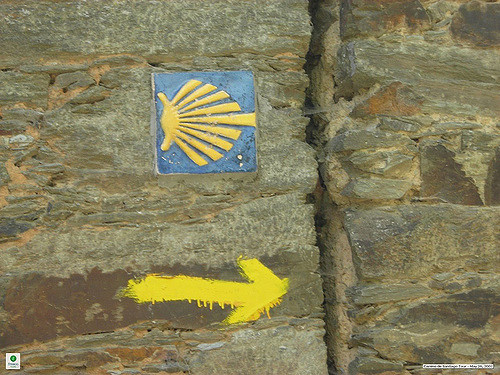
- symbol par excellence of the Camino: the ubiquitous yellow-painted scallop shells. They mark the route; if a pilgrim has been walking a while without seeing one, he or she might want to backtrack a bit
- soles and souls: take care of them and they will take care of you
- Santiago: the destination city and the saint (“Santiago” = Saint James, the Apostle)
- sepulchre: that’s the point (or one of them): to get to the tomb where St. James’ bones are purportedly entombed
- stars: the full name of the city of Santiago is Santiago de Compostela. One theory is that the “Compostela” is derived from the Latin “Campus Stellae” meaning “field of stars.” Legend has it that a shepherd came upon the bones of St. James buried in a field over which a star was shining. A simple church was built there, and then replaced with the splendid cathedral. Wondering when I’ll glimpse the most stars on my journey: before bedtime or as I’m heading off on the trail some mornings?…
- senda / sendero: Spanish for “trail,” “path,” “footpath”
- speaking Spanish: I am so incredibly rusty! ¡Socorro!
- sherpa: now wouldn’t one of those be wonderful to help me schlep my stuff?
- spiders, snakes, scorpions: I haven’t heard anyone caution about these dangers, but I’ve read that a hiker’s sticks can be handy weapons to ward off the snarly stray dogs who threaten pilgrims on occasion. Oh, joy!
- shave: must I? Maybe I just won’t wear shorts…
- Semana Santa: yes, we’ll be in Spain for Holy Week
- saints and sinners: don’t we all possess the characteristics of each, depending on the day, the time, the circumstances? I speculate that I’ll be marching with “the best” of them and stumbling with “the worst”
- serendipity, synchronicity, shenanigans: surely we’ll find examples of each along the way (and who could resist those scintillating multi-syllabic words?
- snow, slope, steep, slip, slide: please, no!
- strength and conditioning: folks in the know have been telling me not to neglect my core; I must strike them as a bit stubborn in my tendency to sidestep their suggestion….
- storytelling: where better than on the Camino? Life stories will speed up the passage of time, swell our hearts with compassion, cause us to forget sore body parts, and, in general, help us sort out our companions on the journey. Some will likely sugarcoat their lives with silver linings; others will skip the less flattering or sordid details of their past. Who will know the difference?
- back scratches: I wonder if Ginny will pinch hit for Ken; if not, I’d better find some scratching posts
- solemn, spiritual, sanctified, surrendering to the sacred: sounds good, at least in theory
- psalms: if you think it is cheating to count this an an “s” word, that might mean you are a bit of a purist, a snob–heaven forbid!–perhaps even a sanctimonious or even a supercilious one. As for me, I’m thinking those psalms could be just as useful as the hiking sticks to keep me upright and on the right path
- sunrise, sunset, sunshine: oh, to be surrounded by beautiful surprises!
- secure, safe & sound, and absolutely spectacular: we’ll hope the Camino experience is all those things!
- spoiled: Yes, I know I am. Spectacularly so!
- stalling: what Katy is doing as she writes this post. And she wonders why she doesn’t get things done! I’d label her “stupid,” but that’s a word that her mother worked so hard to suppress from her vocabulary….
Sex….
How can “sex” be omitted when searching for “s” words? What can I say? Maybe it’s your turn. Select one or more from the following group. After all, if the shoe fits, wear it….

- Shhhh!
- “Sex”? Sounds familiar. Kind of rings a bell. Remind me what that is again. I seem to be having a senior moment.
- Save it; shove it! You’ll survive ’til summer!
- Shame on you for coming up with this section! And, for that matter, with the next one! Where’s the bar of soap to wash out your mouth?
“Sh*t!”
There, I said it again! Where were the hands that were supposed to speed towards my mouth, stuff that word back in, make sure it didn’t hit the air waves? The thing is, with that particular word, there is no advance warning. It doesn’t signal that it’s on its way, doesn’t give an estimated time of arrival. It is, rather, spontaneous and yours truly fails time and time again to stop it from slipping out. As part of my vernacular, it means one (or more!) of the following:
- I dropped it!
- I forgot it!
- I broke it!
- I deleted it accidentally (or, even worse: I sent it!)
- I tripped (over it)!
- I spilled it!
- I goofed!
Or, to sum it up, something didn’t go as planned and I express an uncensored gut reaction. Generally speaking, whatever the goof-up, whatever the “it” was, is of no particular consequence,and, therefore, equilibrium is quickly restored. Unless, of course, I’ve been overheard by someone, in which case I’m a bit embarrassed. Closet cursers do not like to be exposed to the light of day. In the case of this particular curser, she would really like to train herself to come out with the much-more pleasant-to-the-ear “oops!” or even the toned-down “darn!” “Uh ho” might do in a pinch, though it lacks “drama,” failing to convey both the intensity of the surprise factor and the possible depth of disappointment and/or dismay in the face of whatever has just occurred.
So on the Camino I can foresee so many occasions when I might drop things, leave items behind or misplace, break or spill them, or perform any number of unintentional actions which might threaten to disturb the tranquility and flow of my days. Sigh. (Oh, there’s an idea! “Sigh.” I could practice that four-letter “s” word, couldn’t I? Better to be known as the “sigher” than as the “sh*tter“!)
There is one ray of hope, though. I find that on days when “sh*t!” slips out all too easily, it is because I am hurrying too much, multi-tasking, running late, and/or surrounded by so much “stuff” that of course I’m tripping over things and spilling them and dropping them and otherwise being thwarted in my attempts to get to still other things. Whew! Stop! Breathe! Slow down! Be intentional! Remember that you don’t have to “do it all” or “be it all” or “have it all.” That “hope” I mentioned a few breaths back? It’s this: that on the Camino I will indeed be slowing down. I will be simplifying. I will be single-tasking. The first book I read about this pilgrimage in Spain–Joyce Rupp’s Walk in a Relaxed Manner: Life Lessons from the Camino–offers a vision of calmness and serenity towards which I aspire.
Is it too much to hope that some of the other “s” words I’ve suggested above will help me turn the occasional “Sh*t!” into a peace-filled, tranquility-inspiring, lingering “ohmmmm….”? Stand by.

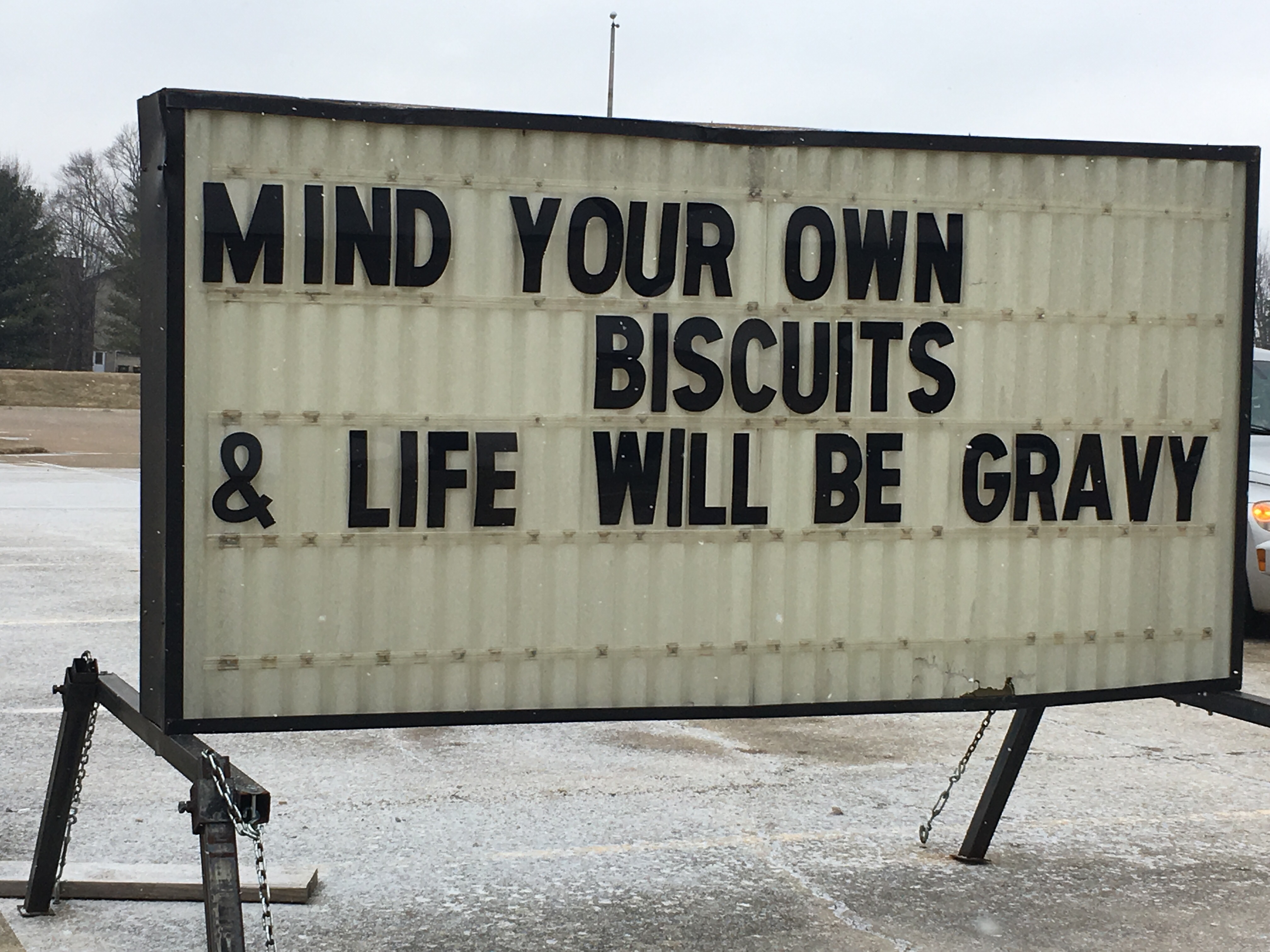

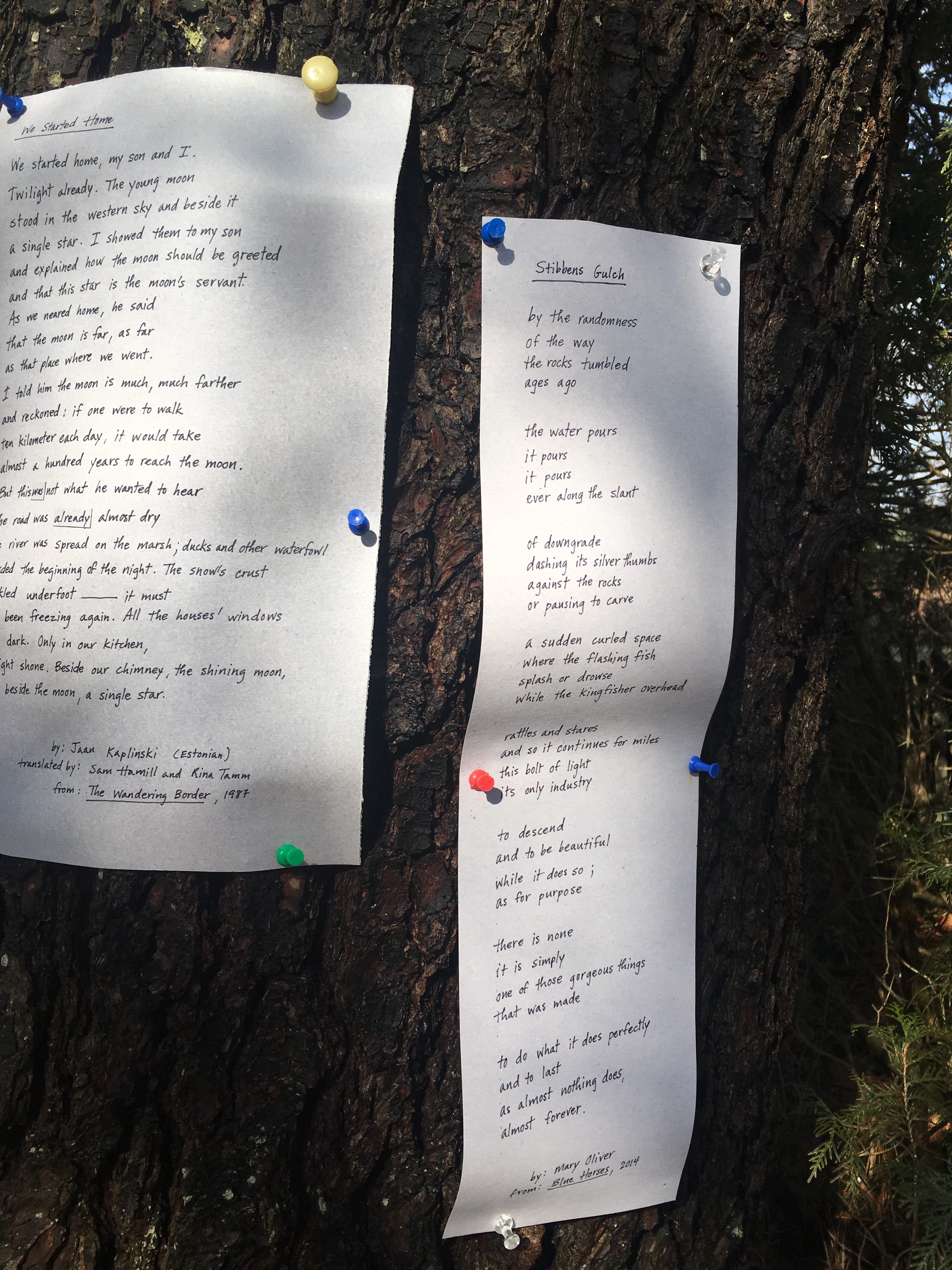
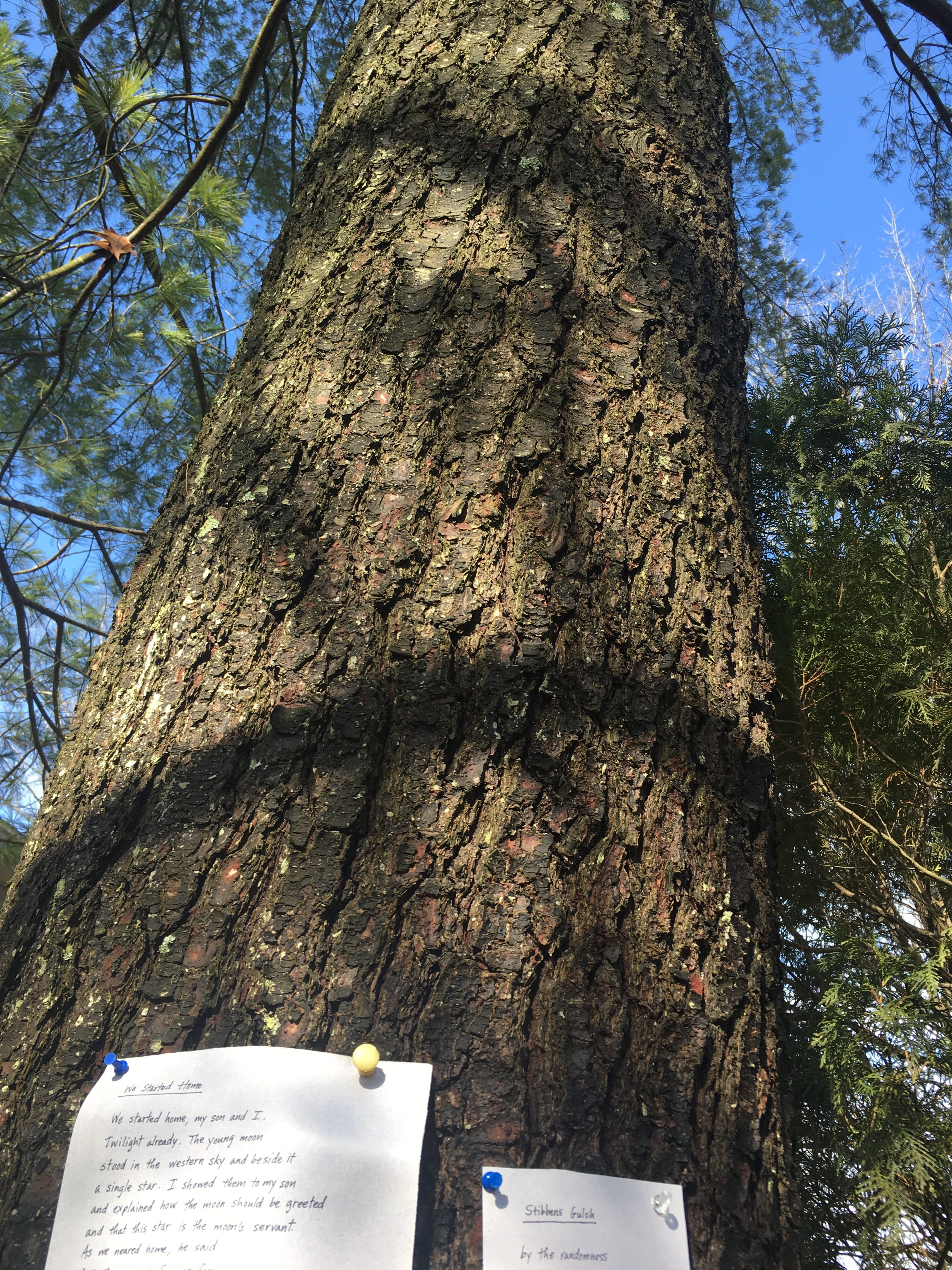



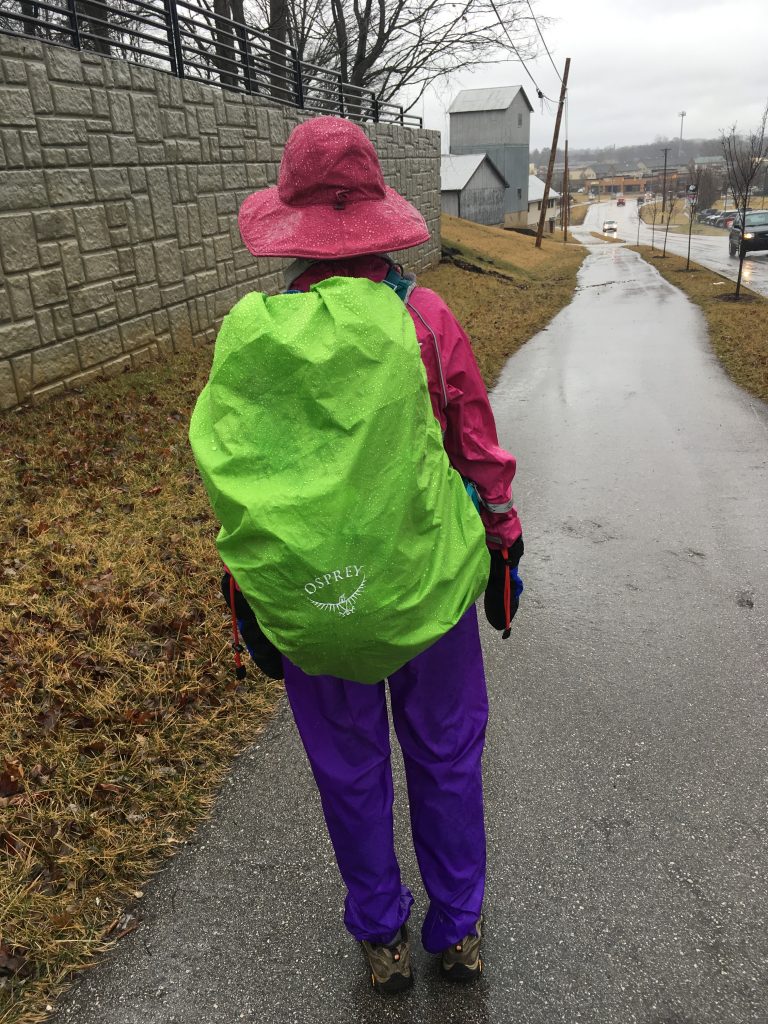
 Yes, we were chilled at the end of the walk, but not even close to what one might call “miserable.” Our conversation, the last mile or two, trended towards the topic of food. Hot soup in particular. Hard to say whether hunger or cold prompted that conversation. No doubt some combination of the two.
Yes, we were chilled at the end of the walk, but not even close to what one might call “miserable.” Our conversation, the last mile or two, trended towards the topic of food. Hot soup in particular. Hard to say whether hunger or cold prompted that conversation. No doubt some combination of the two.